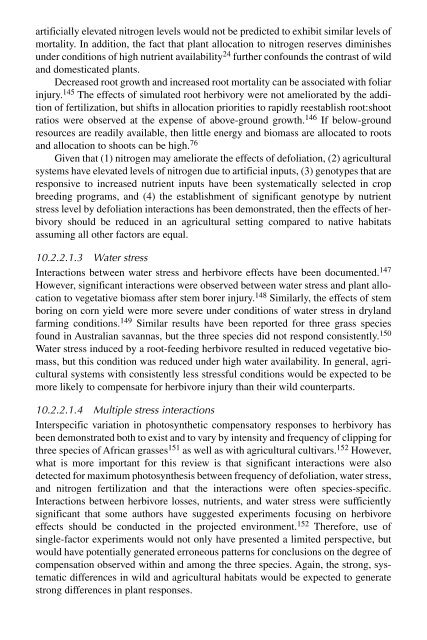Biotic Stress and Yield Loss
Biotic Stress and Yield Loss
Biotic Stress and Yield Loss
- No tags were found...
You also want an ePaper? Increase the reach of your titles
YUMPU automatically turns print PDFs into web optimized ePapers that Google loves.
artificially elevated nitrogen levels would not be predicted to exhibit similar levels ofmortality. In addition, the fact that plant allocation to nitrogen reserves diminishesunder conditions of high nutrient availability 24 further confounds the contrast of wild<strong>and</strong> domesticated plants.Decreased root growth <strong>and</strong> increased root mortality can be associated with foliarinjury. 145 The effects of simulated root herbivory were not ameliorated by the additionof fertilization, but shifts in allocation priorities to rapidly reestablish root:shootratios were observed at the expense of above-ground growth. 146 If below-groundresources are readily available, then little energy <strong>and</strong> biomass are allocated to roots<strong>and</strong> allocation to shoots can be high. 76Given that (1) nitrogen may ameliorate the effects of defoliation, (2) agriculturalsystems have elevated levels of nitrogen due to artificial inputs, (3) genotypes that areresponsive to increased nutrient inputs have been systematically selected in cropbreeding programs, <strong>and</strong> (4) the establishment of significant genotype by nutrientstress level by defoliation interactions has been demonstrated, then the effects of herbivoryshould be reduced in an agricultural setting compared to native habitatsassuming all other factors are equal.10.2.2.1.3 Water stressInteractions between water stress <strong>and</strong> herbivore effects have been documented. 147However, significant interactions were observed between water stress <strong>and</strong> plant allocationto vegetative biomass after stem borer injury. 148 Similarly, the effects of stemboring on corn yield were more severe under conditions of water stress in dryl<strong>and</strong>farming conditions. 149 Similar results have been reported for three grass speciesfound in Australian savannas, but the three species did not respond consistently. 150Water stress induced by a root-feeding herbivore resulted in reduced vegetative biomass,but this condition was reduced under high water availability. In general, agriculturalsystems with consistently less stressful conditions would be expected to bemore likely to compensate for herbivore injury than their wild counterparts.10.2.2.1.4 Multiple stress interactionsInterspecific variation in photosynthetic compensatory responses to herbivory hasbeen demonstrated both to exist <strong>and</strong> to vary by intensity <strong>and</strong> frequency of clipping forthree species of African grasses 151 as well as with agricultural cultivars. 152 However,what is more important for this review is that significant interactions were alsodetected for maximum photosynthesis between frequency of defoliation, water stress,<strong>and</strong> nitrogen fertilization <strong>and</strong> that the interactions were often species-specific.Interactions between herbivore losses, nutrients, <strong>and</strong> water stress were sufficientlysignificant that some authors have suggested experiments focusing on herbivoreeffects should be conducted in the projected environment. 152 Therefore, use ofsingle-factor experiments would not only have presented a limited perspective, butwould have potentially generated erroneous patterns for conclusions on the degree ofcompensation observed within <strong>and</strong> among the three species. Again, the strong, systematicdifferences in wild <strong>and</strong> agricultural habitats would be expected to generatestrong differences in plant responses.

















